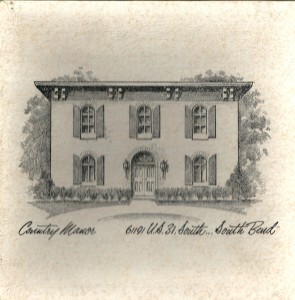Country Manor: it’s where I aspired to live. I clung to a dream with a dead wrong boyfriend during the early ’70s. It was the name of a store where my Hadleyware collection began, gifts from his mother who craved my entrance to the family. Its edifice starred in the story of the idyllic upper middle class life I was creating – the life that I imagined I’d marry into in South Bend, Indiana. I loved the house and its Italian architectural bones: my future foreshadowed, I choose to believe.
Google helped to unravel the mystery of my composite love as I tossed the final gift box from my Hadleyware dishes, the remnant of a failed dream that was replaced by a much fairer version. Yeah, I married an Italian who helped to shape the life of my wishes and aspirations. It’s true that you can’t buy happiness, but you can stake it with “I do!” to the right man.
Italianate (c.1860-1885): This picturesque style, promoted by Andrew Jackson Downing (perhaps a distant relation), recalled the medieval and renaissance Italian domestic architecture of the Tuscan villa. It has also been referred to as the American Bracketed Style due to its most characteristic feature – the cornice brackets. This style became quite popular in the Midwest in the 1860s until the 1890s. Buildings employing this style in Saint Joseph County, Indiana range from residences with simple and symmetrical lines (61191 US 31, the Ullery/Farneman House) to the buildings with assymetrical massings, and porches with elaborate friezes, scrollwork ,and chamfered posts.
A chamfer is a beveled edge connecting two surfaces. Think that my post is camfered by two main men who bracketed my life, beveling my edges in good ways and bad?
Too much reflection and deferred Christmas undecoration – Caio to the box!


I love going through old stuff from the past. It brings up so many memories! Like you said the ups and downs of life.
Christmas – and putting up the ornaments and then taking down – is a great time for memories and reflection, eh. Thanks for reading, enjoying, and responding, Sandy